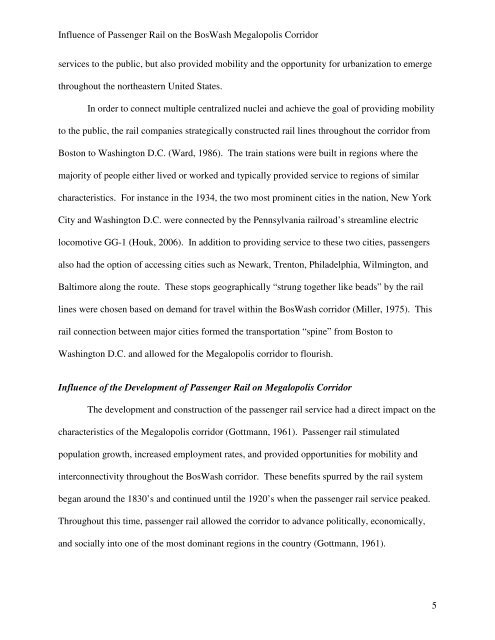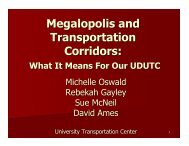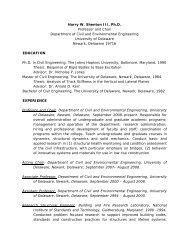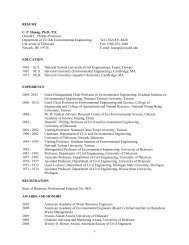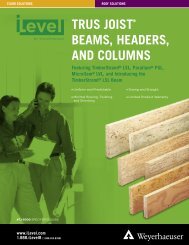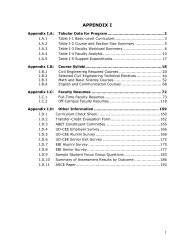Influence of Passenger Rail on the BosWash Megalopolis Corridor ...
Influence of Passenger Rail on the BosWash Megalopolis Corridor ...
Influence of Passenger Rail on the BosWash Megalopolis Corridor ...
You also want an ePaper? Increase the reach of your titles
YUMPU automatically turns print PDFs into web optimized ePapers that Google loves.
<str<strong>on</strong>g>Influence</str<strong>on</strong>g> <str<strong>on</strong>g>of</str<strong>on</strong>g> <str<strong>on</strong>g>Passenger</str<strong>on</strong>g> <str<strong>on</strong>g>Rail</str<strong>on</strong>g> <strong>on</strong> <strong>the</strong> <strong>BosWash</strong> <strong>Megalopolis</strong> <strong>Corridor</strong><br />
services to <strong>the</strong> public, but also provided mobility and <strong>the</strong> opportunity for urbanizati<strong>on</strong> to emerge<br />
throughout <strong>the</strong> nor<strong>the</strong>astern United States.<br />
In order to c<strong>on</strong>nect multiple centralized nuclei and achieve <strong>the</strong> goal <str<strong>on</strong>g>of</str<strong>on</strong>g> providing mobility<br />
to <strong>the</strong> public, <strong>the</strong> rail companies strategically c<strong>on</strong>structed rail lines throughout <strong>the</strong> corridor from<br />
Bost<strong>on</strong> to Washingt<strong>on</strong> D.C. (Ward, 1986). The train stati<strong>on</strong>s were built in regi<strong>on</strong>s where <strong>the</strong><br />
majority <str<strong>on</strong>g>of</str<strong>on</strong>g> people ei<strong>the</strong>r lived or worked and typically provided service to regi<strong>on</strong>s <str<strong>on</strong>g>of</str<strong>on</strong>g> similar<br />
characteristics. For instance in <strong>the</strong> 1934, <strong>the</strong> two most prominent cities in <strong>the</strong> nati<strong>on</strong>, New York<br />
City and Washingt<strong>on</strong> D.C. were c<strong>on</strong>nected by <strong>the</strong> Pennsylvania railroad’s streamline electric<br />
locomotive GG-1 (Houk, 2006). In additi<strong>on</strong> to providing service to <strong>the</strong>se two cities, passengers<br />
also had <strong>the</strong> opti<strong>on</strong> <str<strong>on</strong>g>of</str<strong>on</strong>g> accessing cities such as Newark, Trent<strong>on</strong>, Philadelphia, Wilmingt<strong>on</strong>, and<br />
Baltimore al<strong>on</strong>g <strong>the</strong> route. These stops geographically “strung toge<strong>the</strong>r like beads” by <strong>the</strong> rail<br />
lines were chosen based <strong>on</strong> demand for travel within <strong>the</strong> <strong>BosWash</strong> corridor (Miller, 1975). This<br />
rail c<strong>on</strong>necti<strong>on</strong> between major cities formed <strong>the</strong> transportati<strong>on</strong> “spine” from Bost<strong>on</strong> to<br />
Washingt<strong>on</strong> D.C. and allowed for <strong>the</strong> <strong>Megalopolis</strong> corridor to flourish.<br />
<str<strong>on</strong>g>Influence</str<strong>on</strong>g> <str<strong>on</strong>g>of</str<strong>on</strong>g> <strong>the</strong> Development <str<strong>on</strong>g>of</str<strong>on</strong>g> <str<strong>on</strong>g>Passenger</str<strong>on</strong>g> <str<strong>on</strong>g>Rail</str<strong>on</strong>g> <strong>on</strong> <strong>Megalopolis</strong> <strong>Corridor</strong><br />
The development and c<strong>on</strong>structi<strong>on</strong> <str<strong>on</strong>g>of</str<strong>on</strong>g> <strong>the</strong> passenger rail service had a direct impact <strong>on</strong> <strong>the</strong><br />
characteristics <str<strong>on</strong>g>of</str<strong>on</strong>g> <strong>the</strong> <strong>Megalopolis</strong> corridor (Gottmann, 1961). <str<strong>on</strong>g>Passenger</str<strong>on</strong>g> rail stimulated<br />
populati<strong>on</strong> growth, increased employment rates, and provided opportunities for mobility and<br />
interc<strong>on</strong>nectivity throughout <strong>the</strong> <strong>BosWash</strong> corridor. These benefits spurred by <strong>the</strong> rail system<br />
began around <strong>the</strong> 1830’s and c<strong>on</strong>tinued until <strong>the</strong> 1920’s when <strong>the</strong> passenger rail service peaked.<br />
Throughout this time, passenger rail allowed <strong>the</strong> corridor to advance politically, ec<strong>on</strong>omically,<br />
and socially into <strong>on</strong>e <str<strong>on</strong>g>of</str<strong>on</strong>g> <strong>the</strong> most dominant regi<strong>on</strong>s in <strong>the</strong> country (Gottmann, 1961).<br />
5


